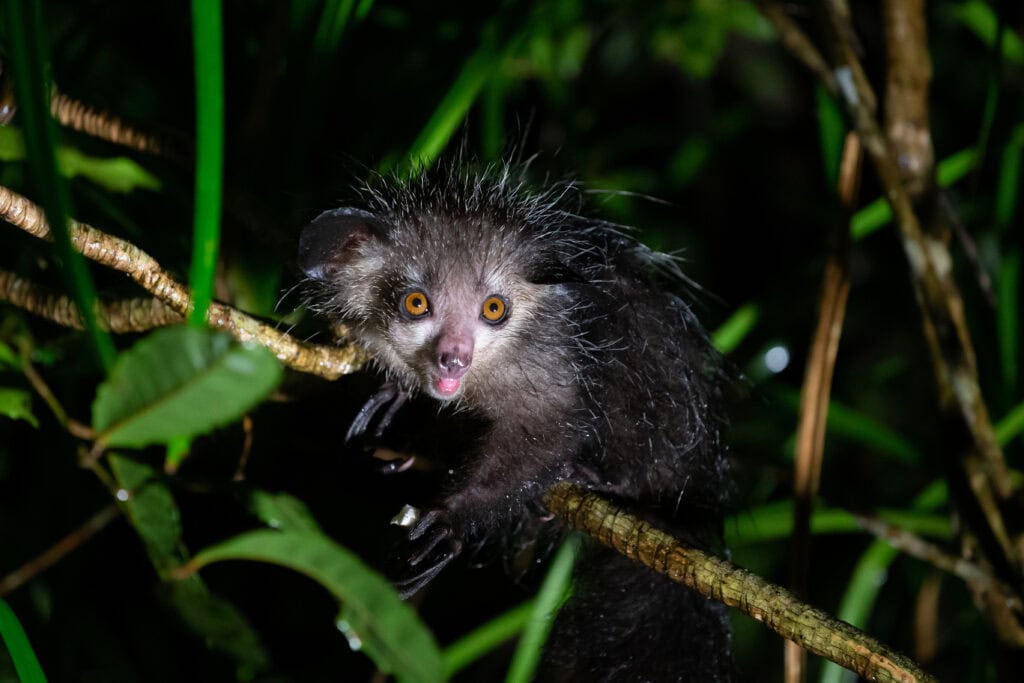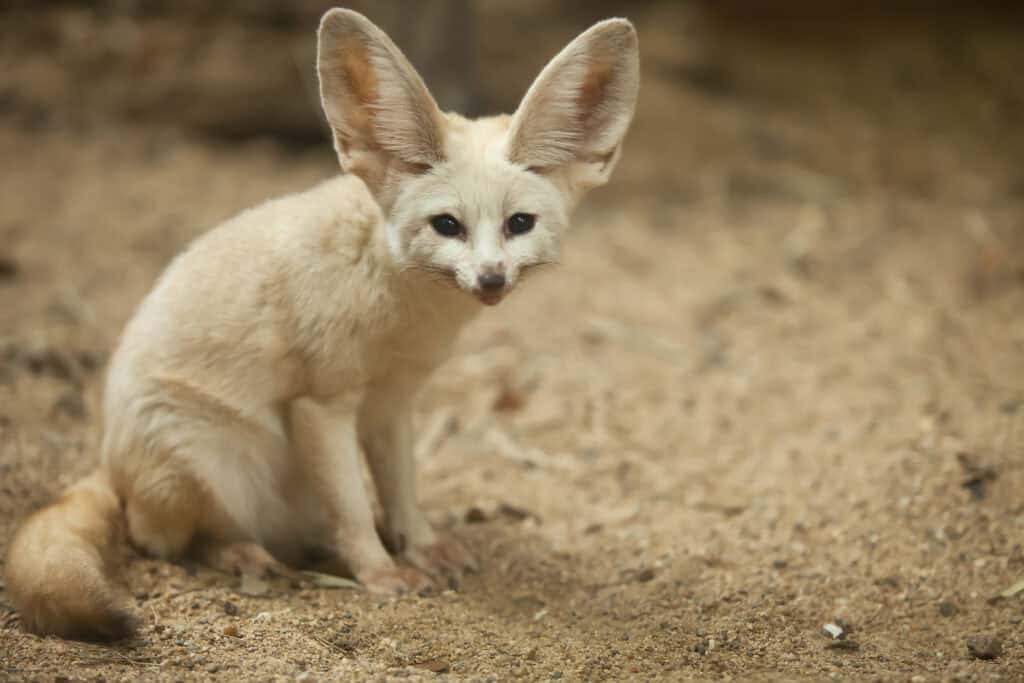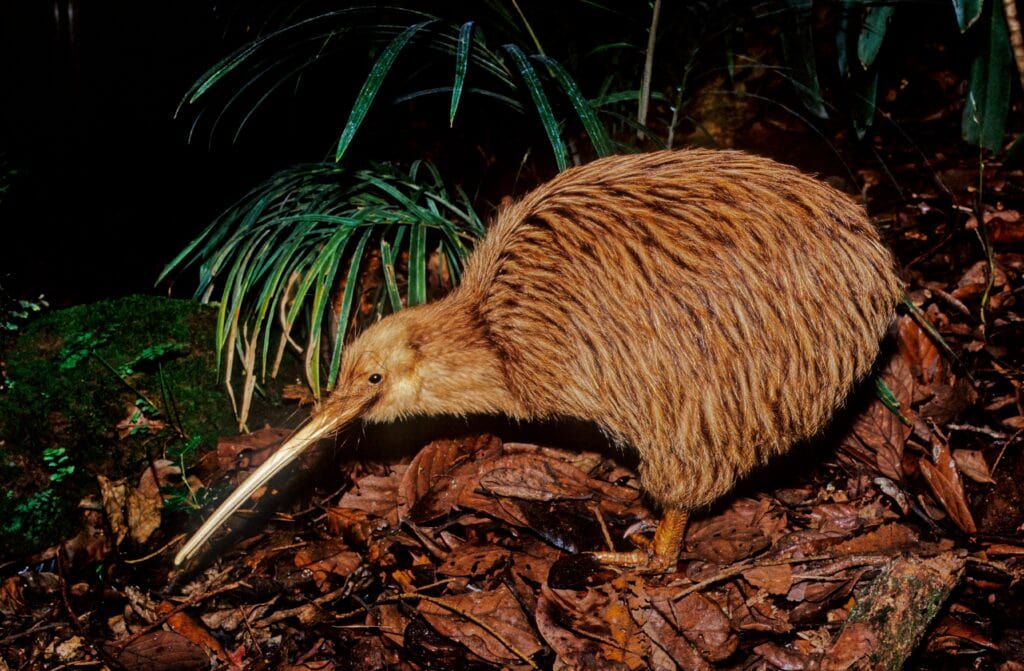Some animals have evolved extraordinary senses to survive the night, allowing them to thrive where light is scarce. From keen hearing to exceptional night vision and even unique ways of detecting prey, these creatures use their special adaptations to navigate and hunt in darkness. Here’s a look at some of the lesser-known nocturnal animals whose impressive senses make them masters of the night.
Aye-Aye (Daubentonia madagascariensis)

The aye-aye, native to Madagascar, is a nocturnal primate renowned for its unique foraging technique. It possesses an elongated middle finger, which it uses to tap on tree bark, listening for hollow sounds that indicate insect larvae beneath the surface. This method, known as percussive foraging, is complemented by its acute hearing, allowing it to detect subtle vibrations. Once it locates its prey, it gnaws through the wood with its ever-growing incisors to extract the larvae. Its large eyes enhance its night vision, enabling it to navigate the dense forests in darkness. Additionally, its whiskers are highly sensitive, aiding in spatial awareness. This combination of tactile, auditory, and visual adaptations makes the aye-aye a proficient nocturnal hunter. Interestingly, it is the world’s largest nocturnal primate and plays a crucial role in seed dispersal, contributing to forest regeneration.
Star-Nosed Mole (Condylura cristata)

The star-nosed mole, found in North America, is distinguished by its star-shaped nasal appendage comprising 22 fleshy tentacles. This unique structure houses over 25,000 sensory receptors called Eimer’s organs, making it one of the most sensitive touch organs among mammals. These receptors allow it to detect minute vibrations and textures in its subterranean environment. Despite its poor eyesight, it can identify and consume prey in as little as 120 milliseconds, making it one of the fastest foragers. Its ability to detect electrical fields emitted by prey further enhances its hunting efficiency. Its exceptional tactile sense compensates for its lack of vision, enabling it to thrive underground. Remarkably, it is also an excellent swimmer, using its sensitive nose to detect prey underwater.
Greater Bulldog Bat (Noctilio leporinus)

The greater bulldog bat, native to Central and South America, is notable for its fishing prowess. It employs echolocation to detect ripples on water surfaces caused by fish movement. Once it locates its prey, it uses its large, clawed feet to scoop fish from the water. Its echolocation calls are finely tuned to detect water disturbances, a specialization uncommon among bats. Additionally, its elongated legs and large feet are adaptations that facilitate successful fishing. Its acute hearing allows it to discern between different types of prey-generated ripples. This combination of echolocation and physical adaptations makes the greater bulldog bat a proficient nocturnal fisherman. Interestingly, it can consume up to 30 fish in a single night, highlighting its efficiency as a predator.
Tarsier (Tarsius spp.)

Tarsiers, small primates found in Southeast Asia, are renowned for their enormous eyes, each larger than their brain. These eyes provide exceptional night vision, crucial for their nocturnal lifestyle. Unlike most mammals, tarsiers lack a reflective layer behind the retina, relying solely on their large eyes to gather light. Their acute hearing complements their vision, allowing them to detect the faintest sounds of prey. They can rotate their heads nearly 180 degrees, compensating for their immobile eyes. This flexibility enables them to have a wide field of view without moving their bodies. Their sensory adaptations make them adept hunters of insects and small vertebrates in the dark. Notably, they are the only entirely carnivorous primates, feeding exclusively on live prey.
Barn Owl (Tyto alba)

The barn owl is distinguished by its heart-shaped facial disc, which functions as a parabolic reflector, channeling sound to its asymmetrically placed ears. This adaptation grants the owl exceptional directional hearing, enabling it to locate prey with remarkable accuracy, even in complete darkness. Its feathers are specially adapted for silent flight, allowing it to approach prey undetected. Its large eyes are highly sensitive to low light, enhancing its night vision. Combined, these sensory adaptations make the barn owl one of the most efficient nocturnal hunters. Its ability to detect and capture prey solely by sound is unparalleled among birds. Interestingly, they can hunt in total darkness, relying entirely on their acute hearing.
Common Vampire Bat (Desmodus rotundus)

Native to the Americas, the common vampire bat has evolved specialized heat sensors on its nose, allowing it to detect blood vessels close to the skin of its prey. This thermoreception guides the bat to optimal feeding sites on its host. Additionally, its sharp teeth can make incisions without waking the host, and its saliva contains anticoagulants to ensure a steady blood flow. Its echolocation is adapted for short-range navigation, aiding in locating hosts in the dark. Its keen sense of smell helps it identify potential prey from a distance. These combined sensory adaptations enable the vampire bat to feed efficiently without detection. Remarkably, they exhibit social behaviors, such as sharing blood meals with roost mates, ensuring group survival.
European Mole (Talpa europaea)

The European mole spends most of its life underground, relying on its acute sense of touch to navigate and hunt. Its snout is covered with sensitive tactile hairs called vibrissae, which detect vibrations and movements of prey like earthworms. Despite its limited vision, its sense of smell is highly developed, aiding in locating food and recognizing territory. Its forelimbs are adapted for digging, with large, spade-like paws that allow it to tunnel efficiently. Its ability to detect seismic vibrations helps it avoid predators and environmental hazards. These sensory and physical adaptations make the European mole a proficient subterranean navigator and hunter.
Tawny Frogmouth (Podargus strigoides)

The tawny frogmouth, native to Australia, is often mistaken for an owl due to its appearance and nocturnal lifestyle. However, it belongs to the nightjar family and has a unique way of sensing prey. This bird has an extraordinary sense of sight adapted to low light, allowing it to spot insects and small animals in near darkness. Its large eyes have a high density of rod cells, which enhance night vision by maximizing light absorption. In addition to excellent eyesight, it has a broad, flat beak covered in sensitive bristles, helping it detect movements around its face. This bristle system acts almost like whiskers, making it particularly responsive to nearby disturbances. Furthermore, its camouflage abilities are outstanding, allowing it to blend seamlessly with tree bark during the day to avoid predators. Remarkably, its nocturnal hunting strategy combines stealth and rapid reflexes, enabling it to capture prey with minimal movement.
Lesser Galago (Galago senegalensis)

The lesser galago, also known as a bush baby, is a small primate found in sub-Saharan Africa with remarkable nocturnal adaptations. Known for its incredible leaping ability, it has large, forward-facing eyes that provide excellent night vision, essential for spotting prey and navigating through dense foliage. Its eyes contain a reflective layer called the tapetum lucidum, which enhances its ability to see in low light by reflecting light within the retina. Its acute hearing also aids in detecting insects and small animals, with large, mobile ears that can pick up faint sounds. Its sense of touch is finely tuned, with delicate fingers that help it grasp branches and capture small prey. Additionally, this primate has a keen sense of smell, assisting in identifying food sources and communicating with other galagos through scent marking. Combined, these sensory adaptations make it highly effective in its nighttime environment. Interestingly, its vocalizations are used to communicate with family members, earning it the nickname “bush baby” for its child-like cries.
Fennec Fox (Vulpes zerda)

The fennec fox, a small fox native to the Sahara Desert, is well-equipped to thrive in its nocturnal lifestyle. It is distinguished by its unusually large ears, which can measure up to six inches and provide an extraordinary sense of hearing. These ears help it detect insects, rodents, and other prey moving underground. It also has specialized fur on its paws that provides insulation against the hot sand and helps muffle sound, allowing it to approach prey quietly. Its eyes are well-adapted for night vision, with a high density of rod cells to enhance its ability to see in low-light conditions. Additionally, it relies on its acute sense of smell to locate food sources across vast desert expanses. These sensory adaptations make it a highly efficient nocturnal hunter in the desert environment. Interestingly, it is also a skilled digger, creating complex burrows to escape the heat during the day.
Kiwi (Apteryx spp.)

The kiwi, a flightless bird native to New Zealand, is known for its extraordinary sense of smell, a rarity among birds. It has nostrils located at the tip of its beak, enabling it to detect insects and worms underground without needing to see them. Its olfactory abilities are among the most developed in the avian world, allowing it to forage in dense underbrush where visibility is limited. Additionally, it has excellent hearing, which helps it detect sounds of prey and predators alike in its forest habitat. Although its eyesight is poor, it relies heavily on its sense of touch, using its long, sensitive beak to feel vibrations in the soil. These adaptations make it uniquely suited to a nocturnal lifestyle, where other senses compensate for its lack of vision. Interestingly, they are known for their monogamous pair bonds, often mating for life and sharing territory.
This article originally appeared on Rarest.org.
More from Rarest.org
16 Most Beautiful and Endangered Coral Reefs

Coral reefs captivate with their stunning colors and rich biodiversity. Yet, these marine treasures face grave threats from climate change and human activities. The following reefs are not only some of the most beautiful but also among the most endangered. Read More.
9 Enigmatic Deep-Sea Creatures That Glow in the Dark

The deep sea holds some of the most fascinating creatures on Earth, many of which have developed the ability to glow in the dark. These bioluminescent animals use their light-producing capabilities for a variety of reasons, including attracting prey, camouflage, or communication. Read More.
14 Rare Gemstones Found Only in Specific Regions

Rare gemstones hold a special allure, not just for their beauty but for their scarcity. Found only in specific regions around the world, these stones are prized by collectors and jewelers alike. The combination of unique geological conditions and limited supply makes each of these gems both valuable and captivating. Read More.
